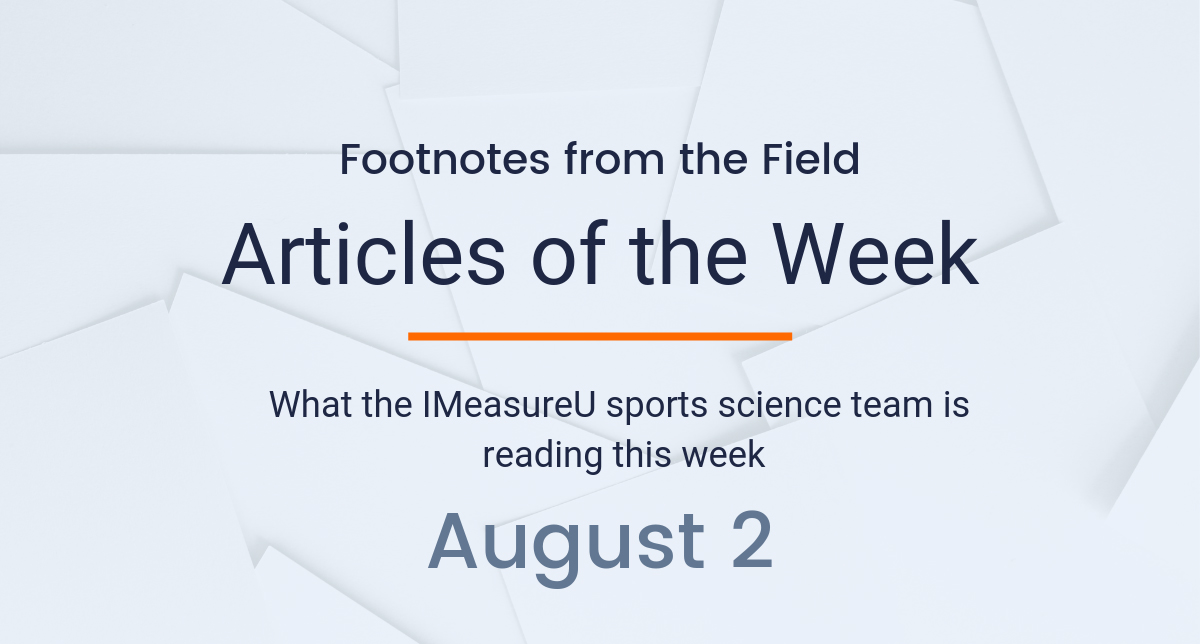
Here’s what the sports science team at IMeasureU is reading this week:
The first article from this edition of the articles of the week comes from Victoria Neilson and colleagues in the Physical Therapy in Sport Journal. With the aim of determine if augmented feedback (AF) used during jump landing training can improve ACL biomechanical injury risk factors, Neilson et al. (2019) concluded that jump landing training combined with AF WAS useful in reducing ACL injury parameters related to peak knee and hip flexion angles and vertical ground reaction force. However it should be noted that men may respond better to visual and women to verbal feedback; therefore, an individualized approach is recommended.
The next article comes from author Matthew Cuthbert at the University of Salford in the Journal of Strength & Conditioning Research. The aim of this paper was to determine the usefulness of evaluated change of direction deficit (CODD) on a 90 degree cut test. The results suggest that the CODD could be
applied to isolate and assess cutting ability in change of direction speed tests that involve a single cutting maneuver and failure to inspect CODD could lead to incorrect evaluation of an athlete’s cutting or COD ability.
This article in the PLOS ONE open access journal comes from Thomas Haugen and colleagues. In this article, Haugen et al. (2019) aimed to quantify differences in sprint mechanical variables across sports and within each sport. The reported that there were substantial differences in sprint mechanical properties across sports. Based on their findings, it may lead some to suggest that the chronic practice of an activity induces different force-velocity profiles in sprint running overtime. However, the large overlap across sports indicates that such variables are more individual than sport-specific.
Our fourth article comes from the Journal of Sports Medicine and Physical Fitness from lead author, Brock Freeman. Freeman et al. (2019) aimed to compare the effects of sprint training and the Nordic hamstring exercise (NHE) on eccentric hamstring strength and sprint performance. Their results suggested that sprint training had a beneficial effect on both eccentric hamstring strength and sprint performance, whilst also producing greater soreness than the NHE following the final training session. They concluded that a four-week block of maximum speed training may have both an injury prevention and performance enhancement benefit.
The last article in this week’s articles of the week comes from Guillaume Mornieux from the University of Lorraine, France in the Journal of Strength & Conditioning Research. Trunk positioning has been shown to be associated with knee joint loading during athletic tasks, especially changes of direction, therefor this paper aimed to test whether a 5-week dynamic and functional core stability training program would improve trunk positioning and knee joint control during lateral movements. The main conclusion from this article was that the 5-week dynamic and functional core stability training program improved core muscle endurance and power. This may explain the better trunk rotation toward the new movement direction during lateral reactive jumps; however, it was not effective during unanticipated cuttings.
For more sports science check out our blog for in-depth case studies and industry updates. Also, be sure to sign up for our newsletter below so you are always up to date with the latest research.




